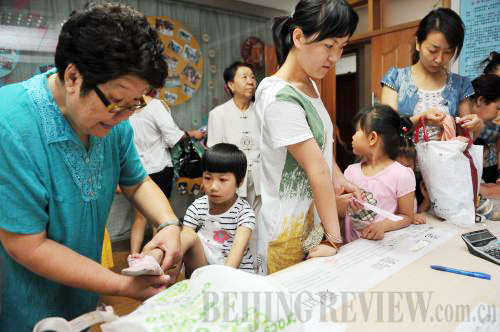|
 |
|
SUMMER SCHOOL: Parents and grandparents register children for summer classes on July 12 in Yinchuan, capital of north China's Ningxia Hui Autonomous Region. During summer vacations, parents often enroll their children in various extracurricular activities, making them as busy as office workers (XINHUA) |
A national conference on education was held on July 13 and 14 in Beijing to promote the implementation of the National Outline for Medium and Long-term Education Reform and Development (2010-2020). The outline was approved by the State Council, the country's cabinet, in May this year.
The outline focuses on promoting fair education and enhancing education quality in order to develop the country's labor resources and basically realize education modernization by 2020.
China gradually established a unified national college entrance examination system after the founding of New China in 1949, but the system was completely destroyed during the "cultural revolution" (1966-76).
In 1977, the late Chinese leader Deng Xiaoping announced the resumption of the national college entrance examination, and since then more than 36 million young people have entered colleges and universities.
By the end of the 20th century, China had nearly realized its nine-year compulsory education target and eliminated illiteracy among the young population.
Despite great achievements over the past three decades, education in China faces many challenges, such as inadequate investment, test-oriented education methods, and unequal access to education.
Investment
The Chinese Government decided in 1993 that expenditures on education should account for 4 percent of the country's total GDP by the end of 2000, and in 2006 set the same goal for the end of 2010. But so far the country has failed to reach either target.
This year's outline once again proposes government expenditures on education will account 4 percent of total GDP by 2012.
Even if China reaches the target of 4 percent, however, when it comes to education the country is far behind the developed world, and even lags behind some underdeveloped countries, Hong Kong-based Takungpao was quoted as saying by Chinanews.com.
The United Nations recommends that investment in education amount to 6 percent of GDP in a country or a region. The current average level is 4.9 percent, while the level in underdeveloped countries stands at 4.1 percent.
Financial input in education is a strategic move for China's long-term development, the outline asserts. Therefore, the government should guarantee a budget for compulsory education.
The local and central government will, in line with their accountability, guarantee education funds for compulsory education, the outline stressed.
As for non-compulsory education, the funds will come mainly from the government, supplemented by money from students and other channels in society. Meanwhile, investment in education will be increased in rural areas, outlying poverty-stricken areas, and areas inhabited by ethnic groups, the outline says.
Fairness
Despite the government's implementation of free compulsory education, access to education continues to be unequal.
First, compulsory education does not cover all areas and populations, such as some areas in west China, some rural areas and the migrant population in some urban areas, ChangCe Thinktank was quoted as saying by Economic Observer.
Second, the quality of education varies, with some primary and middle schools almost matching first-class private schools worldwide, while some are unable to ensure basic quality.
| 